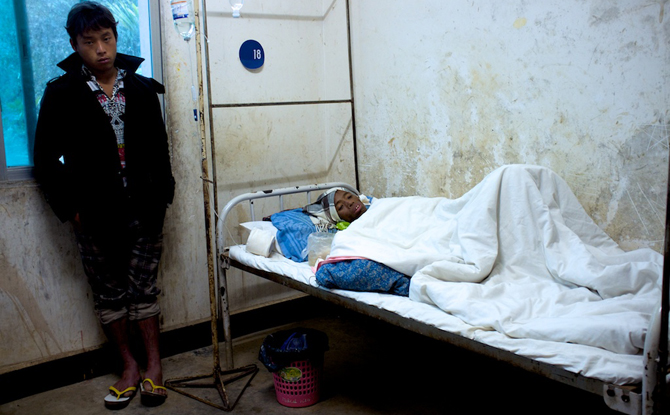Displaced and Distressed

LAIZA, Kachin State—Maran Tu Ring has a broad but cautious smile and the fixed glare of a tired mind. I met him in Laiza in Kachin State, a place he doesn't want to be.
The 54-year-old is an internally displaced person or IDP, a civilian victim of the fighting that broke out in June last year in northeastern Burma.
Since then, the Tatmadaw, or the Burmese armed forces, has reduced the area under the control of the Kachin Independence Army and its political wing, the Kachin Independence Organization (KIO). The fighting has reached a stalemate; both sides say they are seeking a political solution and a ceasefire, but negotiations are tainted by decades of mistrust.
Maran Tu Ring had to abandon his home village of Japu last autumn. He is now living in the Wai Chyai IDP Camp on the outskirts of Laiza, the Kachin Independence Organization's operational capital situated right on the border to China.
"I really want to go home, but I can't," he said. "I have no choice in the matter."
He has been living in the refugee camp for the last four months. His arrival in the giant warehouse that initially provided housing in this camp marked the end of a three-month flight from the conflict to provisional safety in Laiza.
"There are 12 families from my village here," he said. He explained that his own family was dispersed between this camp, another camp in Laiza and a camp in Myitkyina.
According to information provided by the KIO, 2,631 people from 40 villages are currently living in the Wai Chyai IDP Camp.
Some have built primitive bamboo huts, while others continue to live in the two-by-two meter compartments provided by the KIO government in the warehouse.
Most cover the entrance with a cloth for privacy and sleep at night on mats. Most had left all they had in their villages.
“Some youths sneaked back into their villages to get a chicken or a piglet to sell or to eat,” Lt. Geng Du Awng, a KIA officer, told me. “We provide them with rice, but it is scarce.”
No less than 45,678 people have left their homes and sought refuge in camps in China, KIO-controlled areas and government-controlled areas, according to March 4 figures released by the KIO's IDP Refugee Relief Committee (IRRC). Almost half of them are sheltering in Laiza and its outskirts.
More than 5,000 of these displaced people are under five years of age.
"The UNHCR has criticized us for exaggerated numbers, but at the time, we hadn't released any numbers," said Larip, the 41-year old head of the Kachin Development Group and coordinator of the Laiza-based Relief Action Network for IDPs and Refugees (RANIR). "Other people have exaggerated the figures."
"Sometimes the figures have been exaggerated, this creates confusion among politicians and donors," Kareng Awng from RANIR said.
Meters away from Larip's office is the Chinese border. Chinese officials and media have denied the existence of refugee camps on their side over the last months. Chinese journalists have reported on the conflict, but their reports refute the existence of refugee camps on the Chinese side.
One interview on Chinese Central Television showed a local explaining that Kachin people from both sides of the border travel back and forth freely to visit relatives and do business and should not be considered refugees.
“These people are not refugees,” the spokesman for the Chinese Ministry of Foreign Affairs Liu Weimin said at a press conference in Beijing in early February.
According to the IRRC figures, 7,223 refugees are living on the Chinese side of the border. Asked why he thought the Chinese government has denied their existence in recent statements, Larip said, "They might have the understanding that the conflict will be settled very soon. If they say they have refugees, they have to give them refugee status. But they don't want international organizations to get involved in this issue.
"I think, that is one of the reasons why they have facilitated the peace talks," he added. "They want to localize the issue as much as possible—it should not spread and become a big issue."
One single UN convoy brought basic household and shelter supplies to camps near Laiza in December last year. Larip said he has not seen any international help in the IDP and refugee camps either from China or from any other country recently.
In February, the UN Special Envoy for Burma Vijay Nambiar said that the UN had reached an agreement with the Burmese government to allow humanitarian aid to IDPs in KIO-controlled territory.
The scarcity in food is due to restrictive export legislation on the Chinese side, he said.
“We cannot legally bring Chinese food items across the border to IDP camps in KIO-controlled territory,” he said. “A sufficient supply of medicine has also been a challenge.
1 | 2 next page »
|
||
|
||
|
||
|
||
- Students Without a University
- Training the Next Generation of Kachin Rebels
- Rangoon Art Show Provides Arresting Display
- Magical Mandalay Still Holds Court for Tourists
- Distrust and Displacement on Kachin Frontline
- Thein Sein: Reformist or Caretaker?
- School’s Not Out in Kachin State
- Irrawaddy Dolphins are Firm Fisherman’s Friends
- Thein Sein: Reformist or Caretaker?
- For Rangoon Strikers, No End in Sight
